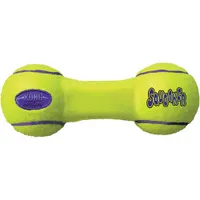If your dog likes to chase other animals when you're on a walk, try this trainer's clever recall tip
Show your dog that a good game of chase with you and a toy is even more fun!

Chasing is a natural behavior for dogs – it’s something they’d have done to find food in the wild. While the drive to chase can differ from breed to breed, and even from dog to dog, with herding and hunting breeds in particular enjoying a good chase, most dogs will show chasing behaviors at one time or another.
If your dog loves to chase other animals, when on a walk, for example, you might be wondering how to get them to come back to you. When your pup’s in the middle of chasing something – or someone – it can seem as though they’re in their own world, but it is possible to teach your dog that coming when you call them is worth their while. And, all you need are patience, encouragement, and one of the best dog toys!
Expert trainer Juliana DeWillems, the founder of JW Dog Training & Behavior, has explained what to try in a recent Instagram post.
A post shared by JW Dog Training & Behavior Consulting (@jwdogtraining)
A photo posted by on
We love this dumbbell for its novel approach to the traditional ball toy. The toy bounces in an erratic and fun fashion when it rebounds off a hard surface – the unpredictable nature will keep your pooch entertained far more than the average tennis ball!
“Smart training is about finding what motivates your dog and working with that instead of against it,” DeWillems begins. In her video, she shows a dog who loves to chase other animals, but instead of using treats, the trainer in the video, Kayleigh Sullivan, begins a game of chase with a toy as soon as the dog turns back toward her.
“Instead of trying to stop or suppress the dog’s desire to chase, we use it to our advantage, understanding the laws of learning,” DeWillems continues. You’re teaching your dog that if they turn away from the animal they’re chasing, they get to chase toys.
She adds, “We systematically build value for the behavior of coming when called in a variety of conditions.”
You may think that your dog would never come when called when they’re in the middle of chasing something, and it might take you plenty of training and encouragement – particularly if they have a high prey drive!
Get the best advice, tips and top tech for your beloved Pets
But be patient when it comes to training recall in dogs – as DeWillems says in her caption, “One important concept when training a solid recall is understanding its not necessarily what you do in that training session or that moment that impacts if your dog comes or not, but more importantly what you’ve done in all the training situations before that. Your dog’s training history has a direct impact on their current behavior.”
It’s also worth using a long line for added safety when you’re teaching your dog to come when called – a long line gives them freedom to move, but also restrains them in a safe fashion while they’re learning that it’s worth coming back to you for a game of chase.
If you’re struggling with recall and you’d like some more advice, you might find this article useful: Three reasons why your dog’s recall isn’t reliable (and what you can do about it).

Adam is a freelance journalist specialising in pets, music and culture, and mental health and wellbeing. He investigates and writes the large majority of news on PetsRadar, and collaborates with veterinary experts to produce informative pet care content.
Adam has a journalism degree from Southampton Solent University and a masters degree in Magazine Journalism from Cardiff University. He was previously senior editor at dog advice website DogTime.com, and has also written for The Independent, GoodToKnow and Healthline.
He owns two rescue cats, Bunny and Dougie, and has also previously had a rabbit, fish and Roborovski dwarf hamsters.

